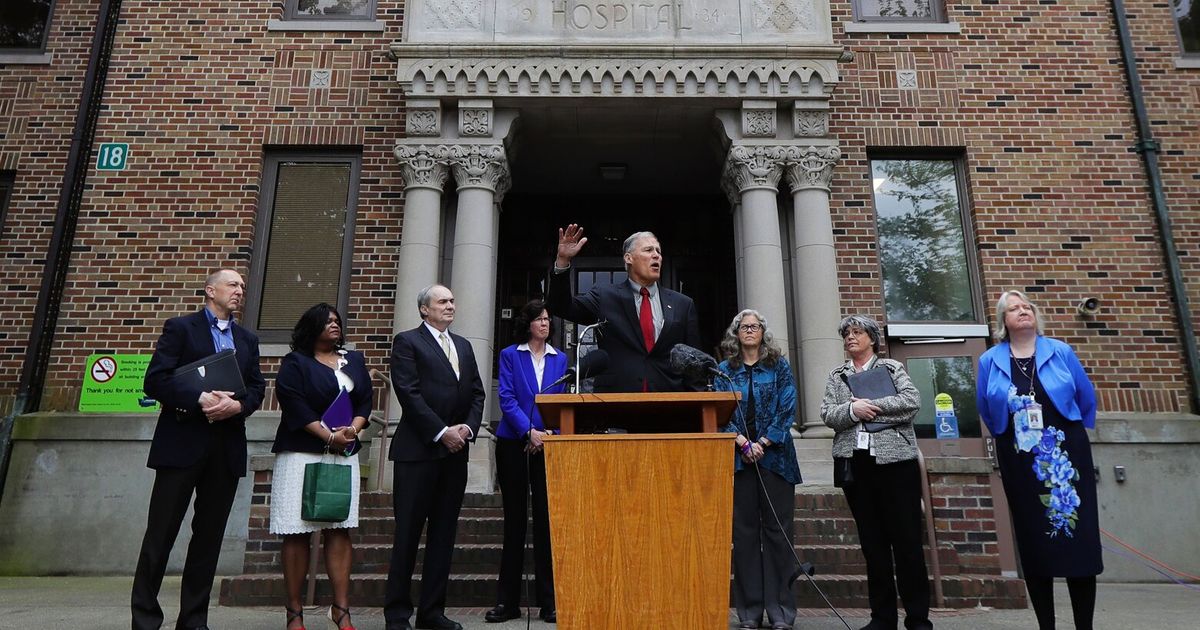
The suits were in town, prepping for a Friday news conference on the brick steps of Western State Hospital.
A photo from that day in Lakewood in May 2018 shows a united front. Hospital officials shoulder to shoulder with state lawmakers, and at the center, Gov. Jay Inslee. These officials were ready to “transform the state’s mental health system” after years of underfunding, lawsuits and federal warnings that threatened to close down Washington state’s largest psychiatric hospital — nearly 800 beds that served some of the most vulnerable residents.
“This is a heavy lift,” Inslee said.
He presented a plan that by 2023 would focus Western State on only serving patients who had been accused of crimes and were coming from jails. State agencies would build new, smaller centers across the state to serve people who weren’t facing charges but were sent for psychiatric commitment by the civil courts.
“It’s an aggressive timeline,” Inslee acknowledged. “2023 is tough, but doable. And it’s necessary.”
It is now 2023. The state failed to meet its goals.
In a quest to revamp mental health care, state officials made a challenging transition even harder — shutting down some of Western State’s wards without the planned community facilities that were supposed to take the people who relied on the state hospital. Combined with the unexpected effects of the pandemic, the resulting logjams have overloaded both jails and psychiatric facilities and left hundreds of incarcerated people languishing without mental health services.
The repercussions have left families and advocates frustrated and have embittered local law enforcement. Often the only two options seem to be either letting people struggle on the streets without care or criminalizing mental health and warehousing them in jail.
Staff and advocates say they warned state officials that the plan needed changes. Mike Yestramski, a social worker by training, remembers that day at Western State in 2018 clearly because he and other hospital union staff were asked to stand in that photo alongside the smiling politicians.
They refused.
“It’s not that we were not supportive of the vision,” explained Yestramski — though union leaders were also concerned that the plan could lead to fewer union jobs in the future. “It was the details, the logistics being worked out … What we’re seeing now come true.”
“We’re moving along by shutting down the civil beds before the community beds were built and ready to go.”
Indeed, this June, another ward is slated for closure — and the patients must go somewhere.
The blueprint
Western State has historically served two main types of patients. Those coming from jails — the state calls them “forensic patients” — need basic mental health services, like evaluations to determine whether they’re competent to stand trial, and restoration treatment to get them back to competency. It also houses “civil patients,” who are not criminally detained but are so seriously sick that they meet the threshold for involuntary commitment through a separate civil court system.
In the past, most of the patients were on the civil side, but in 2015, moves began to shut down the wards where they stayed.
Washington officials were facing challenges on a couple of fronts: The Centers for Medicare & Medicaid Services was scrutinizing Western State more closely after patient-on-patient assaults, threatening a loss of accreditation and federal dollars.
Around the same time, state officials at the Department of Social and Health Services faced a federal lawsuit over allegations they were violating incarcerated people’s due-process rights. People deemed potentially incompetent to stand trial were being held in jail for weeks or months because the state was failing to get them to Western State to get them evaluated or treated.
A federal judge ultimately ordered hospital officials to provide timely services within one to two weeks. Even today, the state is still failing to meet those timelines: In January it was taking about 100 days for patients to receive treatment. Currently, about 464 people are detained in jails across Washington state awaiting competency or restoration mental health services — an additional 344 are waiting out of custody.
In response to these ongoing issues, Washington legislators by spring 2016 had convened a special committee to improve the state hospitals.
Consultants came back with a lengthy report that fall that included nine recommendations. Among their suggestions: Transition the state hospitals into facilities that focus on patients coming from the jails. Build six more long-term civil facilities for patients transitioning out of state hospitals and into the community. Add three mobile crisis teams, and two new crisis centers to pull off the transition.
In May 2018, Inslee, state legislators and government officials announced a plan building off that blueprint, which included the construction of a new forensic hospital on the Western State campus with 350 beds for people coming from jail.
Today, while some of Western State’s last civil wards are set to close in June (delayed from a previous April 1 deadline), few of the other solutions recommended by the consultants exist. Washington has built two of the six civil facilities, most notably a 16-bed facility that debuted in January at Maple Lane near Centralia. Another treatment center in Snohomish County will break ground this spring — with two more facilities in Clark County expected in the winter of 2024.
Additional beds are expected to come online at the University of Washington’s new behavioral health teaching facility at the end of 2023 and at Western State’s forensic hospital in 2027, at the earliest.
In the meantime, however, there are no walk-in crisis centers in King County and by and large, hospital emergency rooms and jails take the responsibility of caring for people, despite the high cost and being ill-equipped to treat people in psychiatric emergencies. Mobile crisis teams are limited in size and are siloed among mental health service providers, police and fire services.
“Do I think everything that we contemplated five years ago is going to be done this year? No,” said Amber Leaders, the senior policy adviser on behavioral health, aging and disability with Inslee’s office.
“We are at a pinch point,” she said, with the civil wards winding down while other housing and treatment options are still coming on line.
“We have made a lot of progress in terms of building up the community capacity that we’ve talked about. But building a brand-new, shiny new forensic hospital takes some time,” Leaders acknowledged.
State Rep. Nicole Macri, who has been deeply involved in the transition of the mental health system since she joined the Legislature in 2017, acknowledged the plan is “behind schedule,” but said “we haven’t lost sight of the goal.”
“We invested over $800 million in behavioral health in the ‘21 and ‘22 sessions. We should have been investing at that scale for years before that,” added Macri, D-Seattle.
She points to the ripple effects of the Great Recession and how it led to significant cuts in funding for these services through the following years. Around that time, under former Gov. Christine Gregoire, state leaders similarly tried to “transform” Washington’s ailing mental health system but found limited success in restitching a complex, fragmented system.
Still, others note missteps in the latest iteration:
“Five years is never a long enough runway when you’re talking about problems that need to be faced with a complete systemic overhaul from top to bottom,” said Lauren Simonds, the executive director of the Washington chapter of the National Alliance on Mental Illness.
Kim Mosolf, director of treatment facilities with the advocacy organization Disability Rights − Washington — which sued over the delays in mental health evaluations and treatment for people in jails — points out that the new community beds that have come up are at best a replacement for what was lost.
“HCA [Washington Health Care Authority] has opened roughly 190 long-term community civil commitment beds since 2018 when they started this project,” she said. “However, they’re [closing] 180 beds at Western State Hospital. So it appears to be a zero sum game.”
Yestramski, the social worker and now president of the Washington Federation of State Employees, said the idea of small facilities closer to patients’ homes was a “great idea on paper” but as state officials soon found out, “the problem is once they set out to build those, you have a lot of issues with NIMBYism.”
Indeed, the construction of a new civil facility in Snohomish County faced “not-in-my-backyard” pushback from the community. Similar attempts to build enhanced services facilities for people with mental illnesses in Auburn and Burien were floated in the last few years but failed when local residents objected.
Kinks in the system
One of the biggest reasons for delays at Western State, though, is the rising number of a particular type of patient. In prioritizing patients coming from jails, officials didn’t account for the fact that the civil and forensic patient populations often intermingle; closing one door had ripple effects in the other.
One perfect example of that is called a civil conversion.
If a patient coming from jail cannot be restored to competency, their criminal charges are typically dropped. Prosecutors can then “flip” their case, kick-starting a separate process that sends the person back to a state hospital but this time for civil treatment. This occurs most often in serious, felony-level cases.
But flipped patients often take four times as long to go through treatment at Western State because they receive more thorough mental health treatment. In comparison, the medication and services given to their jail-based counterparts are often only enough to make them competent in court — meaning they can identify the role of a judge or how to communicate effectively with their attorney.
While a patient coming from jail may spend up to 90 days at the hospital for services, a civil patient can stay for a year or longer.
That valuable space at the hospital causes backlogs for people who are languishing in jail while they wait for a spot to open at Western State. The number of patients being civilly converted has grown dramatically.
On any given day, “That number in the last year has climbed from say traditionally about 30 to 175,” said Thomas Kinlen, the director of the DSHS Office of Forensic Mental Health Services.
Prosecutors increasingly opt for this practice to try to keep people who might be a public safety threat off the street. Both Seattle and King County prosecutors have told The Seattle Times that this method offers at least some treatment for people with severe mental illness — and some respite from community complaints.
However, even when community beds are present, another barrier exists for people discharging from state hospitals — especially if they have complicated backgrounds, like developmental disabilities or a history of violence. The facilities meant to house those civil patients can often decline to take certain people or rescind their placement, a practice common in other parts of the behavioral health system.
Often it’s not financially or logistically feasible for providers to take those patients because they require more staff time and services. That means some of the most vulnerable patients go without appropriate long-term care or housing.
Rick Deluga, a clinical supervisor on the community outreach and assessment team at Downtown Emergency Service Center, sees this first hand. Most of his clients are coming from jails or the hospital, and “they’re basically just getting stabilized and then being returned to where they came from,” he said.
“That’s usually an environment that continues to induce trauma, whether it’s because they’re on the street or they are released to a housing site or a shelter that may not be the best place for them to be due to the level of vulnerability,” he said.
In a 2021 report, the Washington Health Care Authority told legislators about those concerns, saying that some people’s “complex and challenging needs” exceeded what community-based resources could provide.
The report cites the need for better payment rates for these hard-to-place patients, further training for the staff handling their care, specialized facilities for geriatric populations or those with additional needs, and the creation of “no-refusal” facilities who would be forced to accept all patients — essentially, state-run services like those Western State and Eastern State used to provide.
Lisa Corthell, a psychiatrist working at DSHS’ Maple Lane residential treatment facility, said the Western State backlogs are trickling into her work as well.
“Historically, [Western State has] been pretty good about freeing up a bed for us,” Corthell said. Her facility typically takes patients who are considered less acute or sick than the patients who go to the state hospitals.
But in December, a patient of hers had to be transferred to a higher level of care at Western State and she found herself negotiating with the staff: “They said, ‘We can’t take them unless you take one of ours,’” she explained.
“We’re going ‘What?’ We’re not supposed to be getting patients from Western. We’re supposed to be taking patients in from the jails.”
Moving forward
For Western State, the 2018 plan was a little too much, too late. By that summer, the hospital lost the federal accreditation it had hoped to earn back, and with it, about $53 million of funding. Still, the state poured millions into programs to ameliorate delays for mental health services for incarcerated people, and those time frames were starting to improve at last.
Then the pandemic decimated the mental health sphere: More people sought care as workers simultaneously left the field for better pay and safety.
Nevertheless, in 2021 the Legislature tasked DSHS with closing six of Western State’s civil wards in order to make room for the construction of the new forensic hospital that would focus on people coming from jails. In total, 180 people have been or will soon be transferred to community settings.
King County behavioral health officials saw the challenge ahead and pleaded with state legislators not to close the wards before other facilities were in place
“Additional civil ward closures will leave individuals stuck on waiting lists, in community hospitals not designated for psychiatric care and, for some, in homelessness,” they wrote in a 2021 behavioral health agenda.
Police and prosecutors say we’re seeing the effects now. To keep the public safe even as mental health resources remain limited and local jail and police staff numbers drop, law enforcement has relied on arrests to keep people considered dangerous off the street, even as those same people fail to get proper care and get sicker in jail.
Currently, at least 87 people in the King County Jail system are waiting for court-appointed mental health services, out of a population of about 1,200.
Seattle City Prosecutor Ann Davison, who ran on a platform of law and order, is especially frustrated with the inability to get misdemeanor-level detainees mental health services through the state hospitals. State officials chose to focus on providing mental health services to people accused of felonies instead, she said.
Often, if King County prosecutors don’t charge a person with a felony, their case “rolls downhill” to her office, she said. But then that person loses priority for restoration. If they’re not competent, that person will likely just cycle through the jail again.
“It’s as if we’re asking both the community and that person who is struggling to wait until they commit a more serious crime, “ said Davison.
“Only then will we step in and say ‘Well now you are worth it, the problem is worth it.’”
Residents, too, are reckoning with the consequences.
“We feel helpless,” said Tanya Woo, a local volunteer with the CID Community Watch, a group that organizes weekly walks and provides homeless residents with basic needs like socks and food.
Woo has seen residents with mental illnesses cycle through jails, hospitals, drug use and homelessness. While she doesn’t want police to be the first response, she also acknowledges the cycle takes a toll on the local neighborhood, especially when people in crisis become physically combative as a symptom of their illness.
In one instance, Woo tells of a 49-year old man with a history of mental illness who’s had over two dozen interactions with police since the early 2000s — at times he’s spat on people or been arrested for harassment and assaultive behavior.
His charges are often dismissed and Woo wishes there was a way to get him treatment — or at least a heads-up when he is released. Prosecutors or judges tend to dismiss “less serious” charges precisely because of the deadlines that kick in if the detained person is not competent.
Prosecutors then respond by focusing on offenders with the most serious charges, or by going the route of the civil conversion.
Most recently, however, DSHS sent a memo to local officials in December stating the “ability to admit new patients to Eastern State Hospital and Western State Hospital has reached a critical point.”
The state hospitals would no longer admit civil conversion patients, and those individuals could end up being “released from jail into the community.”
While crisis facilities are being floated in King County, and agencies like the state Department of Commerce have invested $160 million in the last biennium to build up facilities, the mental health system transformation promised in 2018 remains stunted with years left to go.
For Washington mental health professionals like Corthell, Yestramski and Deluga and their patients, change has been painstakingly slow.
Still, state officials seem keen with their Sisyphean task.
“This is the first time in quite a long time that I can remember that it feels like the Legislature is truly grasping that we are at an emergency sort of crisis level,” Yestramski said.









